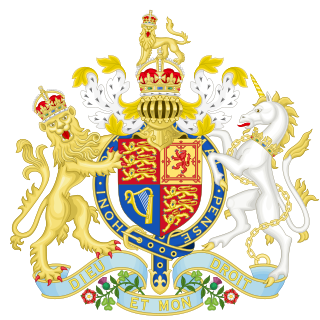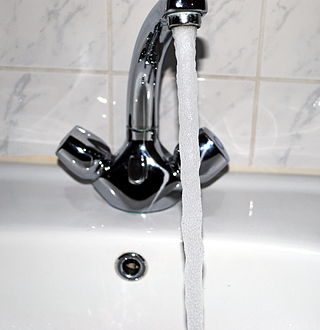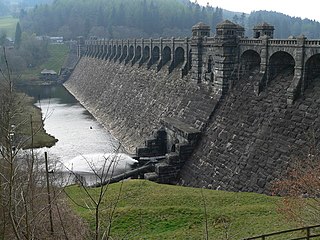The Environment Agency (EA) is a non-departmental public body, established in 1996 and sponsored by the United Kingdom government's Department for Environment, Food and Rural Affairs, with responsibilities relating to the protection and enhancement of the environment in England.
Sewage disposal regulation and administration describes the governance of sewage treatment and disposal.

Anglian Water is a water company that operates in the East of England. It was formed in 1989 under the partial privatisation of the water industry. It provides water supply, sewerage and sewage treatment to the area formerly the responsibility of the Anglian Water Authority. The remaining functions of the authority were transferred to the Environment Agency. Anglian Water is regulated under the United Kingdom Water Industry Act 1991.

Thames Water Utilities Ltd, known as Thames Water, is a large private utility company responsible for the water supply and waste water treatment in most of Greater London, Luton, the Thames Valley, Surrey, Gloucestershire, north Wiltshire, far west Kent, and some other parts of England; like other water companies, it has a monopoly in the regions it serves.

The Water Act 1973 is an Act of the Parliament of the United Kingdom that reorganised the water, sewage and river management industry in England and Wales. Water supply and sewage disposal were removed from local authority control, and ten larger regional water authorities were set up, under state control based on the areas of super-sets of river authorities which were also subsumed into the new authorities. Each regional water authority consisted of members appointed by the Secretary of State for the Environment, and by the various local authorities in its area.

Southern Water is the private utility company responsible for the public wastewater collection and treatment in Hampshire, the Isle of Wight, West Sussex, East Sussex and Kent, and for the public water supply and distribution in approximately half of this area. Some areas within the Southern Water region are supplied by a number of smaller water supply companies. Southern Water supplies an area totalling 4,450 sq. km. and serves 2.26 million customers.
A water board is a regional or national organisation that has very different functions from one country to another. The functions range from flood control and water resources management at the regional or local level, water charging and financing at the river basin level (France), bulk water supply, regulation of pricing and service quality of drinking water supply at the national level (Kenya) or the coordination of water resources policies between various Ministries and agencies at the national level together with the regulation of drinking water supply.

North West Water was a water supply, sewage disposal and sewage treatment company serving North West England. It was established as the North West Water Authority in 1973, and became North West Water plc in 1989, as part of the privatisation of the water industry in England and Wales. In 1995, it merged with NORWEB to form United Utilities.
Wessex Water Services Limited, known as Wessex Water, is a water supply and sewerage utility company serving an area of South West England, covering 10,000 square kilometres including Bristol, most of Dorset, Somerset and Wiltshire and parts of Gloucestershire and Hampshire. Wessex Water supplies 1.3 million people with around 285 million litres of water a day.
Public water supply and sanitation in the United Kingdom is characterised by universal access and generally good service quality. A salient feature of the sector in the United Kingdom compared to other developed countries is the diversity of institutional arrangements between the constituting parts of the UK, which are each described in separate articles, while this article is devoted to some common issues across the United Kingdom.
The WRc Group is a company providing research and consultancy in water, waste and the environment in the United Kingdom. A government body, the Water Pollution Research Board, was set up in 1927 and was merged in 1974 with the Water Research Association and the Water Resources Board to form the Water Research Centre, which was controlled by, and undertook research for, the regional water authorities; the organisation was privatised in 1989 as WRc plc, then acquired by RSK Group in 2020.

The water privatisation in England and Wales involved the transfer of the provision of water and wastewater services in England and Wales from the state to the private sector in 1989, through the sale of the ten regional water authorities (RWA). The potable water supply as well as the sewerage and sewage disposal functions of each RWA were transferred to privately-owned companies.
Severn Trent Water Authority was one of ten regional water authorities established in 1974. Its area of operation was the catchments of the River Trent and River Severn. It assumed the powers and responsibilities of existing water supply authorities in those catchment areas, the Severn River Authority, the Trent River Authority and the sewage and sewage disposal responsibilities of the councils within its area.
Public water supply and sanitation in Scotland is characterised by universal access and generally good service quality. Water and sewerage services are provided by a single public company, Scottish Water. The economic water industry regulator is the Water Industry Commission for Scotland. It "promotes the interests of water and sewerage customers in Scotland by making sure that householders and businesses receive a high-quality service and value for money by setting prices, monitoring Scottish Water's performance and facilitating competition in the water industry". The environmental regulator is the Scottish Environment Protection Agency. Drinking water standards and wastewater discharge standards are determined by the EU.
Public water supply and sanitation in England and Wales has been characterised by universal access and generally good service quality. In both England and Wales, water companies became privatised in 1989, although Dwr Cymru operates as a not-for-profit organisation. Whilst independent assessments place the cost of water provision in Wales and England as higher than most major countries in the EU between 1989 and 2005, the government body responsible for water regulation, together with the water companies, have claimed improvements in service quality during that period.
A regional water authority, commonly known as a water board, was one of a group of public bodies that came into existence in England and Wales in April 1974, as a result of the Water Act 1973 coming into force. This brought together in ten regional units a diverse range of bodies involved in water treatment and supply, sewage disposal, land drainage, river pollution and fisheries. They lasted until 1989, when the water industry was privatised and the water supply and sewerage and sewage disposal parts became companies and the regulatory arm formed the National Rivers Authority. Regional water authorities were also part of the Scottish water industry when three bodies covering the North, West and East of Scotland were created in 1996, to take over responsibilities for water supply and sewage treatment from the regional councils, but they only lasted until 2002, when they were replaced by the publicly owned Scottish Water.
The Welsh National Water Development Authority (WNWDA) and later the Welsh Water Authority was one of ten regional water authorities set up in the UK and came into existence on 6 August 1973 with its headquarters in Brecon. by virtue of the Water Act 1973 It took over the sewerage and sewage disposal responsibilities of the local authorities within its area, the roles and responsibilities of the six existing River Authorities in Wales and most of the water supply undertakings. The authority was dissolved in 1989 as part of the privatisation of the water industry.
Anglian Water Authority was formed in 1974 by virtue of the Water Act 1973 as one of the regional water authorities. It established its headquarters in Huntingdon in Cambridgeshire. The authority boundary was the pre-existing boundaries of the constituent river authorities whose total area made Anglian Water Authority the largest of the ten newly created Authorities. It subsumed the roles and responsibilities of:

The Water Act 1989 is an Act of the Parliament of the United Kingdom that reorganised the bodies responsible for all aspects of water within England and Wales. Whereas previous legislation, particularly the Water Act 1973, had focused on providing a single unifying body with responsibility for all water-related functions within a river basin or series of river basins, this legislation divided those functions up again, with water supply, sewerage and sewage disposal being controlled by private companies, and the river management, land drainage and pollution functions becoming the responsibility of the National Rivers Authority.

Liverpool Corporation Waterworks and its successors have provided a public water supply and sewerage and sewage treatment services to the city of Liverpool, England. In 1625 water was obtained from a single well and delivered by cart, but as the town grew, companies supplied water to homes through pipes. There were two main companies by the 1840s, but the water supply was intermittent, and there was general dissatisfaction with the service. Liverpool Corporation decided that such an important service should be provided by a public body, and sought to take over the water supply companies.








